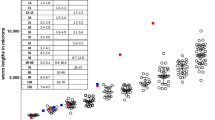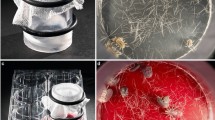Abstract
THE carriage of ringworm by laboratory mice is well documented1–3. Frequently, when the infection is transmitted to those handling infected stock, the mice are killed to control the outbreak4, but when the disease becomes established among animals being examined throughout their life-span, as in some radiobiological and oncogenic experiments, this solution is impracticable. The following is a brief account of attempts to control an outbreak by the use of a dip.
This is a preview of subscription content, access via your institution
Access options
Subscribe to this journal
Receive 51 print issues and online access
$199.00 per year
only $3.90 per issue
Buy this article
- Purchase on Springer Link
- Instant access to full article PDF
Prices may be subject to local taxes which are calculated during checkout
Similar content being viewed by others
References
La Touche, C. J., in The U.F.A.W. Handbook. The Care and Management of Laboratory Animals, second ed., 279 (U.F.A.W., London, 1957).
Dolan, M. M., Kligman, A. M., Kobylinski, P. G., and Motsavage, M. A., J. Invest. Derm., 30, 23 (1958).
Mackenzie, D. W. R., Sabouraudia, 1, 178 (1961).
Parish, H. J., and Craddock, S., Brit. J. Exp. Path., 12, 209 (1933).
Bateman, N., Nature, 191, 721 (1961).
Bourdillon, R. B., Lidwell, O. M., and Thomas, J. C., J. Hyg. (Camb,). 41, 194 (1941).
Author information
Authors and Affiliations
Rights and permissions
About this article
Cite this article
DAVIES, R., SHEWELL, J. Control of Mouse Ringworm. Nature 202, 406–407 (1964). https://doi.org/10.1038/202406a0
Issue Date:
DOI: https://doi.org/10.1038/202406a0
Comments
By submitting a comment you agree to abide by our Terms and Community Guidelines. If you find something abusive or that does not comply with our terms or guidelines please flag it as inappropriate.



